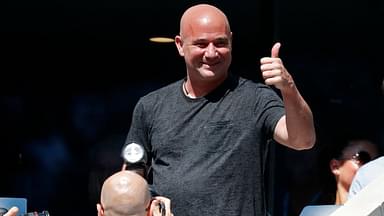Rafael Nadal is one of the best examples of the adage ‘Greatness begins young’. The 22-time Majors winner announced himself on the ATP Tour in the year 2005, when he turned 19. After winning the French Open on his first attempt and another 7 clay court titles, Nadal opted to begin his stint in the North American swing with the Rogers Cup in Montreal. In the final, the Spaniard was up against the great American Andre Agassi, a stalwart of the game. This made for match that screamed battle of the generations and youth took the win here, indicating a changing of the guard.
Since Roger Federer decided to opt out of the event despite being the defending champion, Rafael Nadal was the top-seeded player. However, he was expected to be challenged by seasoned players such as Lleyton Hewitt, Andy Roddick, Juan Carlos Ferrero, Carlos Moya and Andre Agassi for the title.
Nadal vs Agassi: The most anticipated matchup of 2005 between generations
The match had all the hype back then as Rafael Nadal was taking on 35-year-old Andre Agassi, who was 16 years older than him. Agassi had won the tournament previously in 1992, 1994 and 1995 and was aiming for a 4th title towards the twilight of his career. On the other hand, Nadal had a lot to prove on hard courts despite being in the top 5 of the ATP rankings.
The Spanish champion started off aggressively by taking Agassi head-on when it comes to playing on the baseline. The American veteran’s energy and court coverage was impressive for most of the match and especially in the first set. Yet Nadal managed to break his serve once, which was enough for him to take the first set, 6-3, despite squandering one set point at 5-2.
Agassi became more attacking in his approach in the second set, coming more forward to the net especially on his serve to smash the ball away since Nadal’s reach was remarkable. The American bounced back to win the second set, 6-4 after breaking Rafael Nadal in the 10th game of the set. It still showed that Agassi was the best returner the game had even then. However, that set will always be remembered for the Spaniard’s forehand pass shot on the run when Agassi was leading 4-3 but Nadal was serving to level the scores, being on advantage.
The final set had Rafael Nadal breaking Agassi’s serve twice, on the first instance it was at 1-1 which proved to be the final nail in the coffin for the 8-time Grand Slam champion. Nadal repeated the same, extending his 3-1 lead to 4-1 due to a mixture of some powerful baseline shots to which Agassi had no answer as well as the veteran missing out on many points on the net. Eventually, Nadal prevailed 6-2 to clinch his first-ever Masters title in Canada, a feat which he went on to repeat 4 more times in his distinguished career.
In 2005, Nadal ended up with as many as 11 ATP titles which was a stellar, rare achievement for a 19-year-old on the ATP Tour. On the other hand, the match signified a clear change of guard as Agassi quit the game in the summer of 2006 as he ironically lost to Rafael Nadal in the Round of 32 of the Wimbledon Championships. In the same competition, Nadal made it to his first-ever Wimbledon final, which also meant that his rivalry with Roger Federer had clearly taken over tennis.
After the 2005 final, Agassi had famously claimed in public that Nadal is risking his body due to the physicality that his game involves. However, in an interview with Tennis World, he was full of praise for the Spaniard, being rather relieved that he never played him when he was at his level best.
Rafael Nadal US Open record and 10th anniversary of series bonus
Rafael Nadal has won as many as 4 US Open titles, which is only second-best to Roger Federer, Pete Sampras and Jimmy Connors’ 5 wins each. In 2013 and 2019, Nadal went on to clinch the US Open after winning the Canadian Masters. This year is the 10th anniversary of the Spanish legend winning a whopping paycheck of $3.6 million for mastering the North American swing, which also included the Cincinnati Masters. Overall, Nadal has won 5 times in Canada including the Rogers Cup, which is the most by a non-American player ever.








